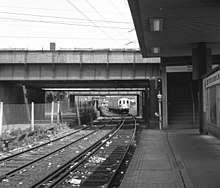West Ham station attack
The West Ham station attack was a bombing and shooting attack at West Ham station in east London on 15 March 1976. A 5 lb bomb on a Metropolitan line train exploded prematurely in the front carriage of the train, injuring seven passengers. The bomb detonated prior to reaching the City of London, where it was thought the intended target was Liverpool Street station at rush hour.[1][2] Adrian Vincent Donnelly, a Provisional Irish Republican Army (IRA) member, then shot Post Office engineer Peter Chalk in the chest, and killed train driver Julius Stephen, who had attempted to catch him.[3] Donelly exited the station to the street and threatened people with his revolver before PC Raymond Kiff caught up with him. Shouting "You English bastards!", Donelly shot himself in the chest, but he survived and was apprehended by Kiff.[4][5]
| West Ham station attack | |
|---|---|
| Part of the Troubles | |
 A platform at the station in 1986 | |
| Location | West Ham, London, United Kingdom |
| Date | 15 March 1976 4:45 pm (UTC) |
Attack type | Bombing and shooting |
| Deaths | 1 |
| Injured | 9 |
| Perpetrator | Adrian Vincent Donnelly (Provisional IRA) |
Perpetrator
Adrian Donelly, 36 at the time, was originally from Castlefin, County Donegal, in the Republic of Ireland but lived in London from 1971. He was part of an active service unit involved in planting 16 bombs. In 1977 at the Old Bailey, he was convicted of murder and attempted murder. He was sentenced to life imprisonment by Mr Justice Croom-Johnson with a minimum of 30 years.[6] He was released after 21 years in August 1998 as one of the earliest beneficiaries of the Good Friday Agreement's prisoner release scheme.[7]
Aftermath
Eleven days prior, an IRA bomb had exploded in a train at Cannon Street station. The day after the West Ham attack, a bomb on a train at Wood Green tube station exploded, injuring a man.[8] On 18 March a 9 lb bomb was discovered in a train at Neasden Depot. After these events, London Transport launched a security operation and assigned 1,000 plainclothed policemen on the London Underground system.[9]
An appeal to raise money was launched for the family of the driver of the train, Julius Stephen, who left behind a widow and a family. £17,000 had been raised by August 1976.[10]
See also
- Cannon Street train bombing
- 1976 Olympia bombing
- Bombings of King's Cross and Euston stations
- Bombings of Paddington and Victoria stations
- Provisional Irish Republican Army campaign 1969–1997
References
- Murders of London: In the Steps of the Capital's Killers by David Long, 2012, p. 36.
- "The Ogden Standard-Examiner from Ogden, Utah on March 17, 1976 · Page 4". Newspapers.com. Retrieved 2018-05-16.
- "1976: Tube driver shot dead". BBC On This Day. 2008. Retrieved 11 November 2017.
- "The Ottawa Journal from Ottawa, on March 17, 1976 · Page 18". Newspapers.com. Retrieved 2018-05-16.
- Stacpoole-Ryding, Richard (2016-09-15). The Railway Policeman's Casebook. Amberley Publishing Limited. ISBN 9781445656472.
- "Adrian Vincent Donnelly jail sentence". Black Kalendar. Retrieved 11 November 2017.
- "BBC News | Latest News | The freed prisoners". news.bbc.co.uk. Retrieved 2018-05-16.
- "Terrorist Attacks on the London Underground". www.nickcooper.org.uk. Retrieved 2018-05-16.
- Weinraub, Bernard (1976-03-19). "1,000 Policemen Assigned to London's Subway After Bombings". The New York Times. ISSN 0362-4331. Retrieved 2018-05-16.
- Jones, Ian (2016-10-31). London: Bombed Blitzed and Blown Up: The British Capital Under Attack Since 1867. Frontline Books. ISBN 9781473878990.